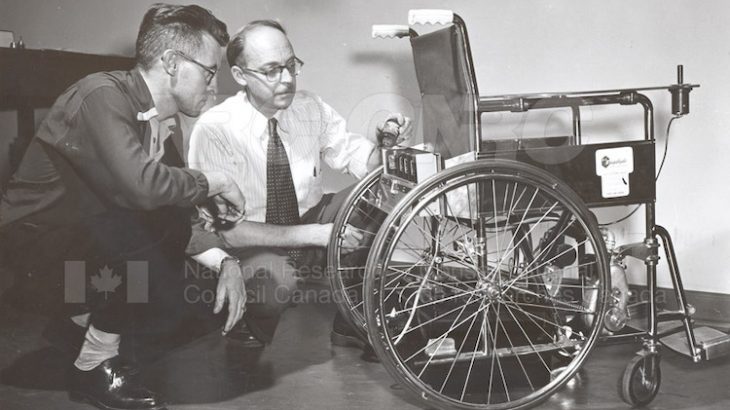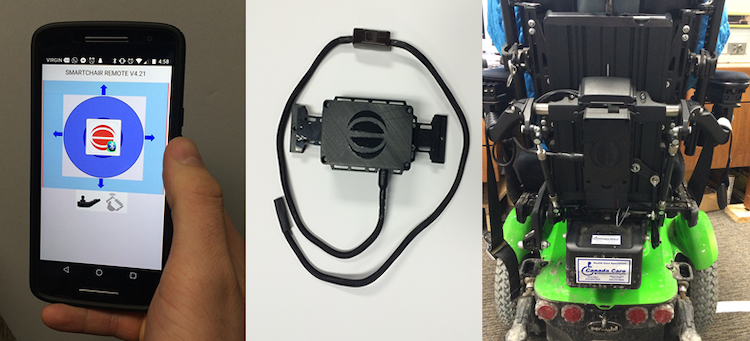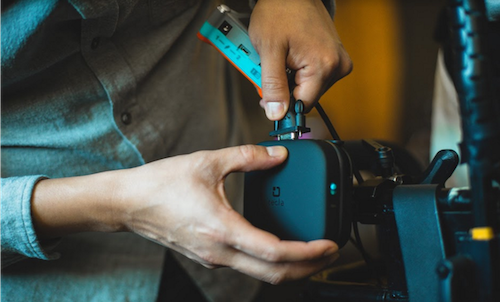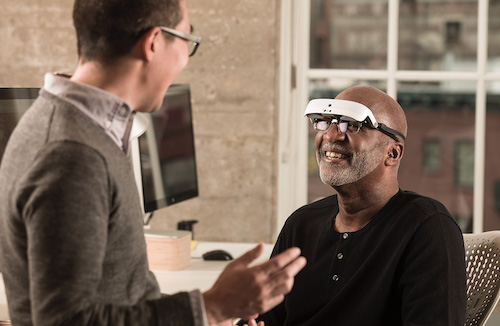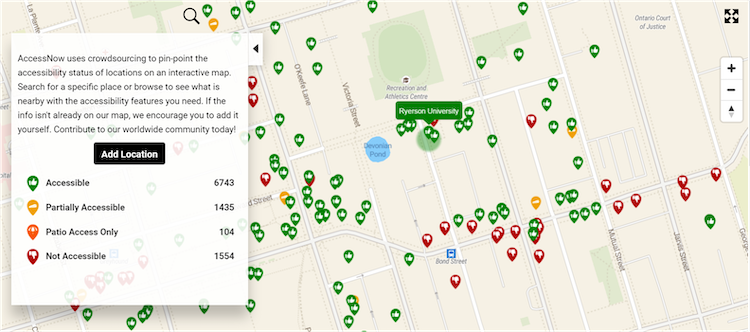Sri Ray-Chauduri, Technology & Engineering editor

George Klein working with his colleague working on a prototype of the first electric wheelchair. Image courtesy of the National Research Council.
Canadians have been front-and-centre in contributing to technological advances in accessibility for people with disabilities. In the 1950s, Canadian engineer George Klein invented the first electric wheelchairwhile working at the National Research Council. Since then, the digital revolution has not only changed the types of innovations needed to improve accessibility but also democratized the makers behind them.
The World Health Organization (WHO) estimates that almost 1 billion people around the world experience some kind of disability. By comparison, the most recent Canadian Survey on Disability (CSD), released last November, found that 6.2 million Canadians over the age of 15 (that’s 1 in 5 people) live with at least one disability that limits their daily activities.
Although the 2017 CSD identified 10 main disability groupings, ranging from mobility to pain to learning, the survey itself is based on the social model of disabilities, which is the idea that a disability results from barriers in society and not solely from a given impairment. This approach to disability is the vision that propels National AccessAbility Week (NAAW) in Canada, an annual event (starting on the last Sunday of May) that promotes accessibility and inclusion in communities and workplaces, including recognizing efforts that have reduced or removed barriers to accessibility.
A major challenge for people with disabilities is gainful employment. The 2017 CSD found that the employment rate for disabled Canadians in their prime working years (24 to 59 years old) was 59 per cent, versus 80 per cent for people without a disability. But research indicates that improving workplace accessibility could not only increase employment rates by allowing more than 500,000 disabled Canadians more opportunities to work but could also increase Canada’s GDP by $16.8 billion by 2030. Although barriers can be mitigated through legal means, public awareness, and how services are offered, technological innovations are critical to improving accessibility and independence for people with disabilities.
In Canada, it is estimated that 80 per cent of people living with a disability use an assistive device or aid to increase their independence.
So what are some of the most interesting “AccessAbility” endeavours going on in Canada today? Here are some recent developments:
Makers Making Change

Makers Making Change Project webpage
Makers Making Change is a website that connects people who need assistive technologies with volunteers who make them. This platform allows sharing of open-source assistive technology designs to address mobility, hearing, vision, cognitive, and dexterity disabilities. People with disabilities, their families, or disability professionals can submit requests for devices to help reduce barriers for themselves, their loved ones, or their clients. Projects can be viewed on the projects page and run the gamut from a repositionable straw to a memory-loss music player to a finger/toe stylus. The program is an initiative of the Neil Squire Society, a not-for-profit organization headquartered in Burnaby, B.C., that has been committed to empowering people with disabilities since 1984.
One of the flagship products of Makers Making Change is LipSync. Designed for those with limited arm and/or hand movement, it is a mouth-controlled joystick with integrated sip and puff controls that only requires limited head and neck movement for a person to operate a touchscreen device. With all the electronic components housed within the head of the device, there is no need for extra control boxes. The project is open-source and can be made at the community level in less than 10 hours for under $300 (as long as there is access to soldering equipment and 3D printing). One of the funding partners is the Accessible Technology Fund, an initiative of the federal government which co-funds efforts to develop adaptive and assistive digital technologies. The program is currently accepting applications and is open to not-for-profit, for-profit, and research institutes.

Left: Cross-section of LipSync device; Right: LipSync in use. Images courtesy of the Neil Squire Society
SmartChair
SmartChair was conceived by Ke Wong, a McMaster University computer engineering graduate, who became disabled after being hit by a SUV while standing at a bus stop. His company, Eightfold Technologies, describes SmartChair as a product that “turns everyday power wheelchairs into autonomous self-driving vehicles controlled by smartphones.” The device relies on the user’s smartphone and a raspberry pi (a low-cost, small single-board computer) to direct the chair’s wheels on how to move. SmartChair automates otherwise time consuming and challenging manoeuvres, such as loading wheelchairs into and out of accessible vehicles, navigating tight spaces like narrow hallways and doorways, or following predefined paths.
Tecla-e
Tecla-e, created by the OCAD University spin-off Komodo OpenLab, is designed to improve access to mobile devices for people with upper body mobility issues. It works by connecting the device to the environment control unit (ECU) box of a powered wheelchair. Once connected, Tecla-e can pair with multiple Bluetooth devices at once (including smart home technologies like Amazon’s Alexa) and users can control and switch between devices using their wheelchair’s driving controls (or ability switches). The Tecla-e also includes built-in sensors that can track the user. This supports a remote monitoring feature that lets family members access sensor information through the cloud.
eSight
eSight makes electronic glasses reminiscent of Star Trek: The Next Generation’s Geordi La Forge’s visor, that are designed to enhance sight for people experiencing vision loss. Conrad Lewis, an electrical engineer, came up with the idea to help his legally blind sisters. The headset works by capturing everything the user is viewing via a high-speed, ultra high-definition, forward-facing camera. An advanced algorithm then optimizes the video, which is transmitted to two small OLED screens positioned in front of both the right and left eye, where the user can see live feeds with minimal lag time, something few other competitors offer.
AccessNow
AccessNow is a crowdsourced mobile app and web platform. Considered the “Yelp of accessibility,” it was founded by Maayan Ziv, a graduate of Ryerson University, who lives with a type of muscular dystrophy. Users can search and rate specific locations like restaurants or hotels, and filter and browse the map to discover accessible places. Users can also add information for unmapped locations. Ziv notes on the website that “the mission is to be able to share enough information so that wherever you are and whatever it is that you want to do you can find an accessible way to do it.”
~
Designing technology to improve accessibility isn’t just an exercise in building cool gadgets or altruism, but makes economic sense for companies too. The estimated purchasing power of those living with disabilities is just over $55 billion in Canada and $490 billion in the United States.
Last year, Microsoft announced a $25 million initiative to use artificial intelligence (AI) to build technology that supports those with disabilities, while Google launched three separate efforts using AI to support assistive technologies. But creating a culture of accessibility doesn’t require big bucks. The Innovative Designs for Accessibility is a competition aimed at Canadian university students to develop solutions to accessibility issues that are both cost effective and innovative.
The truth is we’ve all used assistive technology in our daily lives. Have you ever pushed the automatic door opener, used the ramp at the entrance of a building, or issued spoken commands to your mobile device instead of typing them? Whether it is due to a temporary injury, aging, environmental conditions, or to reduce the burden of a task, assistive technologies allow everyone to better access and engage with the world around them.
~30~

